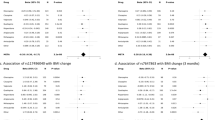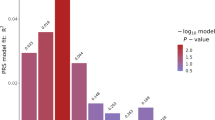Abstract
Antipsychotic-induced weight gain (AIWG) may result in the metabolic syndrome in schizophrenia (SCZ) patients. Downstream variants of the melanocortin-4 receptor (MC4R) gene have been associated with obesity in various populations. Thus, we examined single-nucleotide polymorphisms (SNPs) in the MC4R region for association with AIWG in SCZ patients. Four SNPs (rs2229616, rs17782313, rs11872992 and rs8087522) were genotyped in 224 patients who underwent treatment for SCZ and were evaluated for AIWG for up to 14 weeks. We compared weight change (%) across genotypic groups using analysis of covariance for three SNPs (r2⩽0.8). European-ancestry patients who were rs8087522 A-allele carriers (AG+AA) on clozapine gained significantly more weight than non-carriers (P=0.027, n=69). These observations were marginal after correction for multiple testing. We performed in vitro electrophoretic mobility-shift assay that suggested that the presence of the A-allele may create a transcription factor-binding site. Further investigation is warranted for both these exploratory findings.
This is a preview of subscription content, access via your institution
Access options
Subscribe to this journal
Receive 6 print issues and online access
$259.00 per year
only $43.17 per issue
Buy this article
- Purchase on Springer Link
- Instant access to full article PDF
Prices may be subject to local taxes which are calculated during checkout


Similar content being viewed by others
References
Meyer JM, Nasrallah HA, McEvoy JP, Goff DC, Davis SM, Chakos M et al. The Clinical Antipsychotic Trials of Intervention Effectiveness (CATIE) Schizophrenia Trial: clinical comparison of subgroups with and without the metabolic syndrome. Schizophr Res 2005; 80: 9–18.
Müller DJ, Kennedy JL . Genetics of antipsychotic treatment emergent weight gain in schizophrenia. Pharmacogenomics 2006; 6: 863–887.
McEvoy JP, Meyer JM, Goff DC, Nasrallah HA, Davis SM, Sullivan L et al. Prevalence of the metabolic syndrome in patients with schizophrenia: baseline results from the Clinical Antipsychotic Trials of Intervention Effectiveness (CATIE) schizophrenia trial and comparison with national estimates from III NHANES. Schizophr Res 2005; 8: 19–32.
Meyer J, Loh C, Leckband SG, Boyd JA, Wirshing WC, Pierre JM et al. Prevalence of the metabolic syndrome in veterans with schizophrenia. J Psychiatr Pract 2006; 12: 5–10.
Callaghan RC, Boire MD, Lazo RG, McKenzie K, Cohn T . Schizophrenia and the incidence of cardiovascular morbidity: a population-based longitudinal study in Ontario, Canada. Schizophr Res 2009; 115: 325–332.
Gebhardt S, Theisen FM, Haberhausen M, Heinzel-Gutenbrunner M, Wehmeier PM, Krieg JC et al. Body weight gain induced by atypical antipsychotics: an extension of the monozygotic twin and sib pair study. J Clin Pharm Ther 2010; 35: 207–211.
Wang Y, Lobstein T . Worldwide trends in childhood overweight and obesity. Int J Pediatr Obes 2006; 1: 11–25.
Santini F, Maffei M, Pelosini C, Salvetti G, Scartabelli G, Pinchera A . Melanocortin-4 receptor mutations in obesity. Adv Clin Chem 2009; 48: 95–109.
Arch JR . Central regulation of energy balance: inputs, outputs and leptin resistance. Proc Nutr Soc 2005; 64: 39–46.
Huszar D, Lynch CA, Fairchild-Huntress V, Dunmore JH, Fang Q, Berkemeier LR et al. Targeted disruption of the melanocortion-4 receptor results in obesity in mice. Cell 1997; 88: 131–141.
He S, Ye Z, Dobbelaar PH, Bakshi RK, Hong Q, Dellureficio JP et al. Discovery of highly potent and efficacious MC4R agonists with spiroindane N-Me-1,2,4-triazole privileged structures for the treatment of obesity. Bioorg Med Chem Lett 2010; 20: 6524–6532.
Srisai D, Gillum MP, Panaro BL, Zhang XM, Kotchabhakdi N, Shulman GI et al. Characterization of the hyperphagic response to dietary fat in the MC4R knockout mouse. Endocrinology 2011; 152: 890–902.
Vaisse C, Clement K, Guy-Grand B, Froguel P . A frameshift mutation in human MC4R is associated with a dominant form of obesity. Nat Genet 1998; 20: 113–114.
Loos RJ, Lindgren CM, Li S, Wheeler E, Zhao JH, Prokopenko I et al. Common variants near MC4R are associated with fat mass, weight and risk of obesity. Nat Genet 2008; 40: 768–775.
Speliotes EK, Willer CJ, Berndt SI, Monda KL, Thorleifsson G, Jackson AU et al. Association analyses of 249 796 individuals reveal 18 new loci associated with body mass index. Nat Genet 2010; 42: 937–948.
Brönner G, Sattler AM, Hinney A, Soufi M, Geller F, Schäfer H et al. The 103I variant of the melanocortin 4 receptor is associated with low serum triglyceride levels. J Clin Endocrinol Metab 2006; 9: 535–538.
Heid IM, Vollmert C, Kronenberg F, Huth C, Ankerst DP, Luchner A et al. Association of the MC4R V103I polymorphism with the metabolic syndrome: the KORA Study. Obesity (Silver Spring) 2008; 16: 369–376.
Malhotra AK, Correll CJ, Chowdhury NI, Müller DJ, Gregersen PK, Lee AT et al. Common variants near the melanocortin 4 receptor gene are associated with severe antipsychotic drug–induced weight gain. Arch Gen Psychiatry (in press).
Tiwari AK, Zai CC, Likhodi O, Lisker A, Singh D, Souza RP et al. A common polymorphism in the cannabinoid receptor 1 (CNR1) gene is associated with antipsychotic-induced weight gain in schizophrenia. Neuropsychopharmacology 2010; 35: 1315–1324.
Masellis M, Basile V, Meltzer HY, Lieberman JA, Sevy S, Macciardi FM et al. Serotonin subtype 2 receptor genes and clinical response to clozapine in schizophrenia patients. Neuropsychopharmacology 1998; 19: 123–132.
Basile VS, Masellis M, De Luca V, Meltzer HY, Kennedy JL . 759C/T genetic variation of 5HT(2C) receptor and clozapine-induced weight gain. Lancet 2002; 360: 1790–1791.
Volavka J, Czobor P, Sheitman B, Lindenmayer JP, Citrome L, McEvoy JP et al. Clozapine, olanzapine, risperidone, and haloperidol in the treatment of patients with chronic schizophrenia and schizoaffective disorder. Am J Psychiatry 2002; 159: 255–262.
Müller DJ, Klempan TA, De Luca V, Sicard T, Volavka J, Czobor P et al. The SNAP-25 gene may be associated with clinical response and weight gain in antipsychotic treatment of schizophrenia. Neurosci Lett 2005; 379: 81–89.
Lahiri DK, Nurnberger JI . A rapid non-enzymatic method for the preparation of HMW DNA from blood for RFLP studies. Nucleic Acids Res 1991; 19: 5444.
Dudbridge F . Pedigree disequilibrium tests for multilocus haplotypes. Genet Epidemiol 2003; 25: 115–121.
Barrett JC, Fry B, Maller J, Daly MJ . Haploview: analysis and visualization of LD and haplotype maps. Bioinformatics 2005; 21: 263–265.
Gauderman WJ, Morrison JM . 2006. QUANTO 1.1: a computer program for power and sample size calculations for genetic-epidemiology studies. 2007. http://hydra.usc.edu/gxe.
Norris RA, Kern MJ . The identification of Prx1 transcription regulatory domains provides a mechanism for unequal compensation by the Prx1 and Prx2 loci. J Biol Chem 2001; 276: 26829–26837.
Towler DA, Rutledge SJ, Rodan GA . Msx-2/Hox 8.1: a transcriptional regulator of the rat osteocalcin promoter. Mol Endocrinol 1994; 11: 1484–1493.
Nasrallah HA . The urgent need for monitoring and intervention to reduce metabolic risk factors in patients with schizophrenia. CNS Spectr 2008; 13: 5–6.
Renström F, Payne F, Nordström A, Brito EC, Rolandsson O, Hallmans G et al. GIANT Consortium. Replication and extension of genome-wide association study results for obesity in 4923 adults from northern Sweden. Hum Mol Genet 2009; 18: 1489–1496.
Espinoza CA, Ren B . Mapping higher order structure of chromatin domains. Nat Genet 2011; 43: 615–616.
Granell S, Mohammad S, Ramanagoudr-Bhojappa R, Baldini G . Obesity-linked variants of melanocortin-4 receptor are misfolded in the endoplasmic reticulum and can be rescued to the cell surface by a chemical chaperone. Mol Endocrinol 2010; 24: 1805–1821.
Beckers S, Zegers D, de Freitas F, Mertens IL, Van Gaal LF, Van Hul W . Association study of MC4R with complex obesity and replication of the rs17782313 association signal. Mol Genet Metab 2011 May; 103 (1): 71–75.
Acknowledgements
This study was supported by Canadian Institutes of Health Research (CIHR) operating grants to JLK: Strategies for Gene Discovery in Schizophrenia, MOP 15007, and Neurodevelopmental Genetics of Human Psychiatric Disorders, 200508GMH; CIHR operating grant to DJM (Genetics of antipsychotic-induced metabolic syndrome, MOP 89853); National Alliance for Research in Schizophrenia and Depression (NARSAD) Young Investigator Award; a CIHR Michael Smith New Investigator Salary Prize for Research in Schizophrenia; and an OMHF New Investigator Fellowship to DJM; MH41468, Funding from the Prentiss Foundation, Ritter Foundation, Hintz family, and the Peterson Family to HYM; Centre for Addiction and Mental Health postdoctoral fellowship to AKT; National Alliance for Research in Schizophrenia and Depression Award (NARSAD) to AKT; and CIHR fellowship XWY93967 to RPS.
Author information
Authors and Affiliations
Corresponding authors
Ethics declarations
Competing interests
NIC, AKT, RIS, CCZ, SAS, SC, FL and DJM report no competing interests. HYM has received grants from or is a consultant to Abbott Labs, ACADIA, Bristol Myers Squibb, Eli Lilly, Janssen, Pfizer, AstraZeneca, GlaxoSmithKline, Memory, Cephalon, Minster, Aryx and BiolineRx, and is also a shareholder of ACADIA. JAL reports that he serves on the advisory boards of Bioline, GlaxoSmithKline, Intracellular Therapies, Eli Lilly, Pierre Fabre, Psychogenics and Wyeth. He does not receive financial compensation or salary support for his participation as an advisor, but receives grant support from Allon, Forest Labs, Merck and Pfizer, and holds a patent from Repligen. Dr AKM is or has been a consultant to Eli Lilly, Merck, Janssen, BMS and Vanda Pharmaceuticals, Sunovion Pharmaceuticals, Shire Pharmaceuticals and Genomind. JLK has been a consultant to GSK, Sanofi-Aventis and Dainippon-Sumitomo, and the recipient of a one-time honorarium from Eli Lilly Corporation.
PowerPoint slides
Rights and permissions
About this article
Cite this article
Chowdhury, N., Tiwari, A., Souza, R. et al. Genetic association study between antipsychotic-induced weight gain and the melanocortin-4 receptor gene. Pharmacogenomics J 13, 272–279 (2013). https://doi.org/10.1038/tpj.2011.66
Received:
Revised:
Accepted:
Published:
Issue Date:
DOI: https://doi.org/10.1038/tpj.2011.66
Keywords
This article is cited by
-
Mechanism and treatments of antipsychotic-induced weight gain
International Journal of Obesity (2023)
-
Genetic association of the rs17782313 polymorphism with antipsychotic-induced weight gain
Psychopharmacology (2023)
-
Clinical pharmacogenomics in action: design, assessment and implementation of a novel pharmacogenetic panel supporting drug selection for diseases of the central nervous system (CNS)
Journal of Translational Medicine (2021)
-
Genome-wide association study of morbid obesity in Han Chinese
BMC Genetics (2019)
-
Pharmacogenetic Tests for Antipsychotic-Induced Weight Gain
Pharmaceutical Chemistry Journal (2019)



